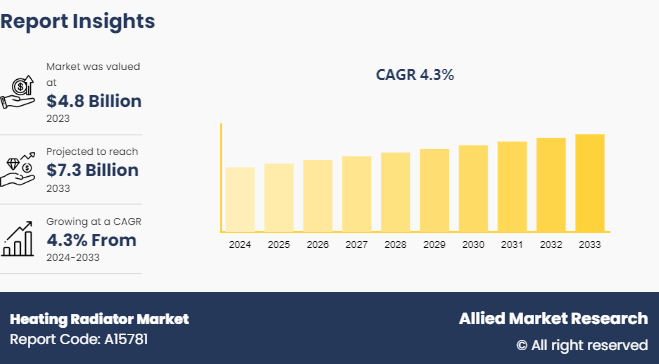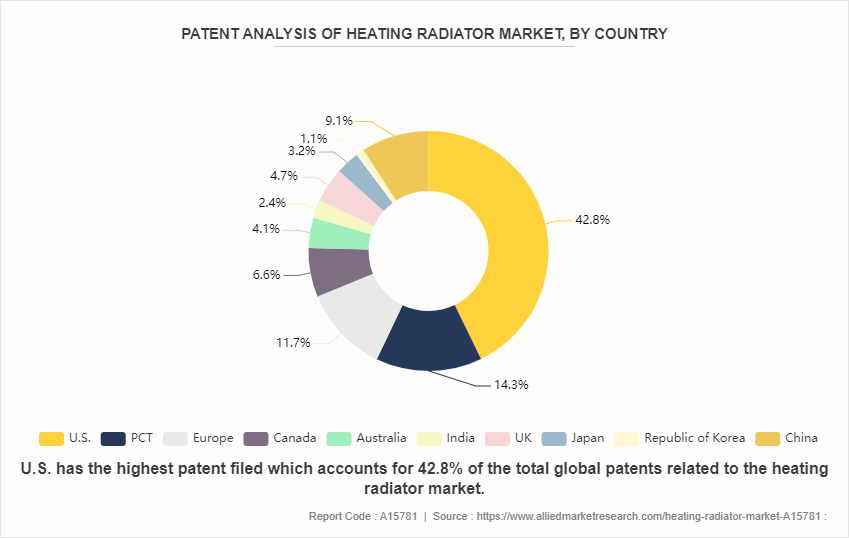Heating Radiator Market Research, 2033
The global heating radiator market size was valued at $4.8 billion in 2023, and is projected to reach $7.3 billion by 2033, growing at a CAGR of 4.3% from 2024 to 2033.

Market Introduction and Definition
A radiator heater is a heating system that uses hot water or steam to heat a room. The heat is generated by a boiler which heats the water or moisture and then sends it through pipes to the radiator. Radiator heaters work by using convection to heat a room. Convection is the transfer of heat through a fluid such as water or steam. The hot water or steam flows through the pipes to the radiator, heating the air around it. As the air heats up, it rises, and cooler air moves in to take its place. As a result, it creates a convection current that circulates warm air throughout the room.
Key Takeaways
The heating radiator market report covers 20 countries. The research includes a segment analysis of each country in terms of value ($Billion) for the projected period 2023-2033.
More than 2,200 product literatures, industry releases, annual reports, and other such documents of major heating radiator industry participants along with authentic industry journals, trade associations' releases, and government websites have been reviewed for generating high-value industry insights.
The study integrated high-quality data, professional opinions and analysis, and critical independent perspectives. The research approach is intended to provide a balanced view of global markets and to assist stakeholders in making educated decisions to achieve their most ambitious growth objectives.
Key Market Dynamics
Heating systems account for a substantial portion of overall energy usage in buildings, making energy efficiency a crucial factor in the selection of heating equipment. Radiators have emerged as a popular choice due to their ability to provide efficient heat distribution and control, resulting in lower energy bills and reduced greenhouse gas emissions. Manufacturers such as Runtal North America, Inc, and Boiler Company, LLC, in the heating radiator market have responded to this demand by developing advanced radiator technologies that prioritize energy efficiency. These include radiators with improved heat transfer capabilities, better insulation, and smart controls that allow precise temperature regulation and zonal heating. In addition, the integration of renewable energy sources, such as solar thermal or geothermal systems, with radiator heating has gained traction, further enhancing energy savings and environmental sustainability. All these factors are expected to drive the demand for the heating radiator market during the forecast period.
However, the heating radiator market relies heavily on various raw materials, such as metals (e.g., steel, aluminum, copper) , plastics, and insulation materials. These raw materials are subject to price fluctuations driven by factors such as global supply and demand dynamics, geopolitical tensions, trade policies, and commodity market speculation. When the prices of these raw materials rise, it directly impacts the manufacturing costs of heating radiators. Manufacturers face increased overhead expenses, which can erode profit margins or necessitate passing on these additional costs to consumers through higher product prices. All these factors hamper the growth of the heating radiator market growth.
The adoption of advanced polymer composites and lightweight materials offers superior insulation properties, corrosion resistance, and durability, while also reducing the overall weight of the radiators. This led to improved energy efficiency, easier installation, and reduced transportation costs, making radiators more appealing to both residential and commercial customers. In addition, the integration of phase change materials (PCMs) and advanced heat storage technologies into radiator designs revolutionize the way heat is distributed and stored. Phase change materials have the ability to absorb and release large amounts of thermal energy, enabling radiators to store heat during off-peak hours and release it when needed, leading to significant energy savings and enhanced thermal comfort. All these factors are anticipated to offer new growth opportunities in global heating radiator market forecast.
Patent Analysis For Heating Radiator Market

The U.S. collectively hold nearly half of the total heating radiator patents that indicate strong innovation and investment in this technology in U.S. countries. This suggests fierce competition and a significant focus on heating radiator R&D in these leading economies. U.S. has the highest patent filed those accounts for 42.8% of the total global patents related to the heating radiator. Europe and PCT, although holding smaller percentages of heating radiator patents individually, collectively contribute to the overall Asian dominance in heating radiator innovation. This reflects the region's strong presence in materials science and engineering R&D.
Market Segmentation
The heating radiator market is segmented into type, radiator type, application, and region. Based on type, the market is classified into plumbed, electric, dual fuel, and oil-filled. By radiator type, the market is classified into ceramic radiators, freestanding cast-iron radiators, baseboard steam system. By application, the market is divided into residential, commercial, and industrial. Region-wise the market is analyzed across North America, Europe, Asia-Pacific, and LAMEA.
Regional Market Outlook
Northern China, winter temperatures dip well below freezing, making adequate heating an absolute necessity. Cities such as Beijing, Harbin, and Shenyang regularly face sub-zero temperatures and heavy snowfall during the winter months. In these regions, radiators have become a popular choice for residential and commercial heating due to their ability to provide consistent and evenly distributed warmth throughout the indoor spaces. In addition, Japan, particularly the northern regions such as Hokkaido and the mountainous areas, experience severe winter conditions. The combination of low temperatures, heavy snowfall, and strong winds necessitates efficient heating systems that maintain comfortable indoor temperatures. Radiators have proven to be an effective solution in these areas, as easily integrated into existing heating networks and provide reliable warmth without compromising valuable living or working space.
Ireland’s Climate Action Plan (CAP) emphasizes ambitious targets related to heat pumps, reflecting the country’s commitment to combatting climate change and reducing greenhouse gas emissions. The key heat pump-related targets for 2025 are 215 000 heat pumps in new and existing buildings in 2025 and 680 000 in 2030. According to the plan they will cease new gas connections or new fossil heating system installations in new or refurbished buildings and the ambition is to transition all buildings to heat pumps or district heating by 2050.
Competitive Landscape
The major players operating in the heating radiator market overview Runtal North America, Inc., Hunt Heating, Annu Engineering Industries., Stelrad Limited 2024., Boiler Company, LLC, KORADO, IRSAP, Zehnder Group AG, H2O Heating Pty Ltd, VASCO, and Others.
Technological Trend Analysis:
Electric radiator technology has revolutionized home heating, offered superior efficiency and incorporated smart technology into living spaces. Modern electric radiators such as the electric series, operate independently of central heating systems, showcasing significant advancements in both efficiency and design. These cutting-edge radiators represent a major leap forward, providing innovative and efficient heating solutions for contemporary homes.
Smart Radiators: The integration of smart technology in electric radiators is a game changer. Smart electric radiators connected to home automation systems, allowing you to control your heating from anywhere. Whether you’re on your way home from work or cosy in bed, you adjust the temperature with ease using your smartphone or tablet when connected to a central home hub.
E-Flow Technology: Electric E-Flow radiators, combining a towel radiator design with a built-in fan heater, offer an efficient and versatile solution for various rooms such as bathrooms and utility rooms. Electric E-Flow radiator provides the option of instant heat through the fan heater located at the base, alongside the standard heating function of the radiator. This dual functionality ensures that both the room and towels are heated quickly and effectively.
Aesthetic and Functional Upgrades: Electric radiators are designed with aesthetics in mind. Modern designer electric radiators range from sleek and minimalistic to bold and artistic, that’s make them a statement piece in any room. Moreover, the absence of pipes and complex installation processes allows for cleaner lines and more freedom in placement, ensuring that your radiator complements the décor rather than clashing with it.
Industry Trends
The U.S. Environmental Protection Agency has introduced new regulations for boilers with the goal of significantly reducing environmental emissions. While over 88% of major source boilers comply with emission regulations through annual tune-ups, about 12% need refurbishment or replacement to cut down on harmful emissions.
The UK government aims to install 600, 000 heat pumps annually by 2028 to decrease reliance on fossil fuels and combat global warming. In April 2022, the Boiler Upgrade Scheme was introduced, offering grants up to EUR 6, 000 (USD 6, 438) to support the installation of heat pumps, benefiting approximately 90, 000 homes.
According to Climate Action Plan, the Irish government aims to replace oil and solid fuel boilers with heat pumps powered by renewable electricity, targeting the installation of 600, 000 heat pumps by 2030, including 400, 000 in existing buildings. This initiative is supported by a EUR 12.9 billion (USD 13.8 billion) allocation for the Department of the Environment, Climate, and Communications under Ireland's revised National Development Plan (NDP) 2021-2030. Additionally, the government plans to retrofit 500, 000 buildings with insulation to achieve a B2-equivalent rating by 2030.
Key Sources Referred
Invest India
International Renewable Energy Agency (IREA)
International Energy Agency (IEA)
India Brand Equity Foundation (IBEF)
Green Building Council
Agile Alliance
Key Benefits For Stakeholders
This report provides a quantitative analysis of the market segments, current trends, estimations, and dynamics of the heating radiator market analysis from 2024 to 2033 to identify the prevailing heating radiator market opportunities.
The market research is offered along with information related to key drivers, restraints, and opportunities.
Porter's five forces analysis highlights the potency of buyers and suppliers to enable stakeholders make profit-oriented business decisions and strengthen their supplier-buyer network.
In-depth analysis of the heating radiator market statistics segmentation assists to determine the prevailing market opportunities.
Major countries in each region are mapped according to their revenue contribution to the global heating radiator market share.
Market player positioning facilitates benchmarking and provides a clear understanding of the present position of the market players.
The report includes the analysis of the regional as well as global heating radiator market trends, key players, market segments, application areas, and market growth strategies.
Heating Radiator Market Report Highlights
| Aspects | Details |
| Market Size By 2033 | USD 7.3 Billion |
| Growth Rate | CAGR of 4.3% |
| Forecast period | 2024 - 2033 |
| Report Pages | 340 |
| By Type |
|
| By Radiator Type |
|
| By Application |
|
| By Region |
|
| Key Market Players | Runtal North America, Inc., H2O Heating Pty Ltd, Boiler Company, LLC, KORADO, Annu Engineering Industries, Hunt Electric Supply Co Inc, Stelrad Limited, VASCO Inc, Hunt Heating, Zehnder Group AG |
Increasing demand for energy-efficient heating solutions, technological advancements in heating radiators are the upcoming trends of heating radiator market.
Residential is the leading application of Heating Radiator Market
Asia-Pacific is the largest regional market for Heating Radiator.
$7.3 billion is the estimated industry size of Heating Radiator, by 2033.
Runtal North America, Inc., Hunt Heating, Annu Engineering Industries., Stelrad Limited 2024., Boiler Company, LLC, KORADO, IRSAP, Zehnder Group AG, H2O Heating Pty Ltd, VASCO are the top companies to hold the market share in Heating Radiator
Loading Table Of Content...



